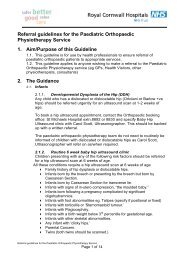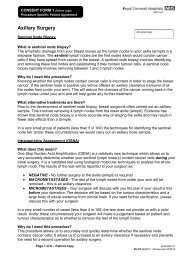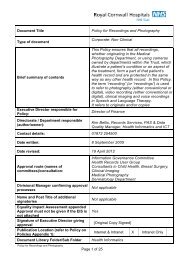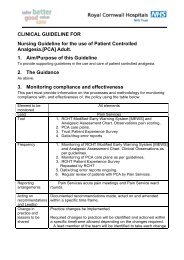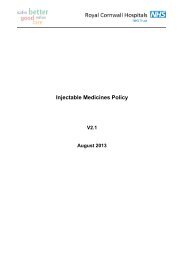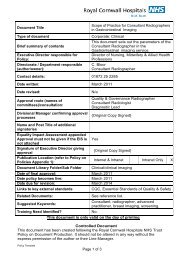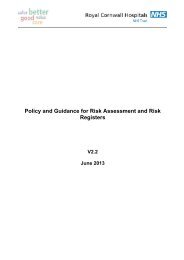Catheterisation in Adults - the Royal Cornwall Hospitals Trust ...
Catheterisation in Adults - the Royal Cornwall Hospitals Trust ...
Catheterisation in Adults - the Royal Cornwall Hospitals Trust ...
Create successful ePaper yourself
Turn your PDF publications into a flip-book with our unique Google optimized e-Paper software.
4.25 Ca<strong>the</strong>ter Ma<strong>in</strong>tenance SolutionsThere is m<strong>in</strong>imal evidence to identify if <strong>the</strong> use of solutions provides any benefit (Hagen et al2010). However, for ca<strong>the</strong>ters tha t block due to encrust ation result<strong>in</strong>g <strong>in</strong> a freq uency ofca<strong>the</strong>ter change that is unacceptab le to <strong>the</strong> pa tient, <strong>the</strong>n a prescribed regime of an acidi cca<strong>the</strong>ter ma<strong>in</strong>tenance solution may be cl<strong>in</strong>ically justif ied for short-t erm use. It is notrecommended to use solutions for unblock<strong>in</strong>g a ca<strong>the</strong>ter that is no longer dra<strong>in</strong><strong>in</strong>g.The pr<strong>in</strong>ciple aim of us <strong>in</strong>g a solution is to wa sh <strong>the</strong> ca<strong>the</strong>ter, not <strong>the</strong> bladder. The term‘bladder washout’ has been superseded by <strong>the</strong> more appropriate term of ‘ca<strong>the</strong>terma<strong>in</strong>tenance solution’. The effectiveness o f acidic cat heter ma<strong>in</strong>tenance solutions <strong>in</strong>dissolv<strong>in</strong>g encrustations has been demonstrated <strong>in</strong> laboratory-based studies. However, th e<strong>in</strong>stillation of solutions for ei<strong>the</strong>r encrustation or debris via an <strong>in</strong>dwell<strong>in</strong>g ur<strong>in</strong>ary ca<strong>the</strong>ter isnot recommended as a rout<strong>in</strong>e measure as th eir efficacy has not be en proven <strong>in</strong> larg ecl<strong>in</strong>ical trials. If prescribed howeve r, <strong>the</strong>y shou ld only be u sed for a s hort period of time ,us<strong>in</strong>g <strong>the</strong> smallest volume (50mls or less) and discont<strong>in</strong>ued if not effective. Frequency ofuse will need to be determ<strong>in</strong>ed on an <strong>in</strong>dividual patient basis.The use of solutions can cause damage to <strong>the</strong> mucosa, caus<strong>in</strong>g irritation and spasm if <strong>the</strong> yenter <strong>the</strong> bladder. For fur<strong>the</strong>r guidance, please see <strong>the</strong> ‘Treatment Al gorithm for Long-termCa<strong>the</strong>ters’ <strong>in</strong> Appendix 5. Please consult <strong>the</strong> Bladder & Bowel Specialist Service (01726291042) or hospital specialist nurse if fur<strong>the</strong>r advice is needed.4.26 Use of AntibioticsAntibiotic prophylaxis is not recommended for cardiac malfunction/stents/valves accord<strong>in</strong>g toNICE Guidel<strong>in</strong>es (NICE 2008). For any fur<strong>the</strong>r <strong>in</strong>formation on when antibiotics may berequired, please consult with Cl<strong>in</strong>ical Microbiology.For those with sympto matic ca<strong>the</strong>ter associated ur<strong>in</strong>ary tract <strong>in</strong>fection, t he ca<strong>the</strong>ter shouldbe changed at <strong>the</strong> start of antibiotic <strong>the</strong>rapy.4.27 Decision to Remove Ca<strong>the</strong>terIn secondary care and community hospital sett<strong>in</strong>gs, daily review of cat heters is essential tom<strong>in</strong>imise length of time <strong>in</strong> place with <strong>the</strong> aim to reduce healthcare acquired <strong>in</strong>fections.For community hospitals, we encourage <strong>the</strong> use of <strong>the</strong> Stop-Order:On admission all patients with an <strong>in</strong>dwell<strong>in</strong>g urethral ur<strong>in</strong>ary ca<strong>the</strong>ter will haveremoved with<strong>in</strong> 72 hours.ca<strong>the</strong>terExceptions1. ur<strong>in</strong>ary obstruction lead<strong>in</strong>g to ur<strong>in</strong>ar y retention (where <strong>in</strong>termittent ca<strong>the</strong>terisation is notviable)2. neurogenic bladder and ur<strong>in</strong>ary retention (where <strong>in</strong>termittent ca<strong>the</strong>terisation is not viable)3. urological surgery4. open sacral wounds (stage 3 or 4) for <strong>in</strong>cont<strong>in</strong>ent patientsAll exceptions should be fully documented and reviewed every 7 daysIf any concerns, please contact <strong>the</strong> patient’s medical team or <strong>the</strong> Bladder & Bowel Serviceon 01726 29104211 of 16




